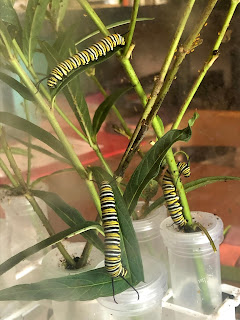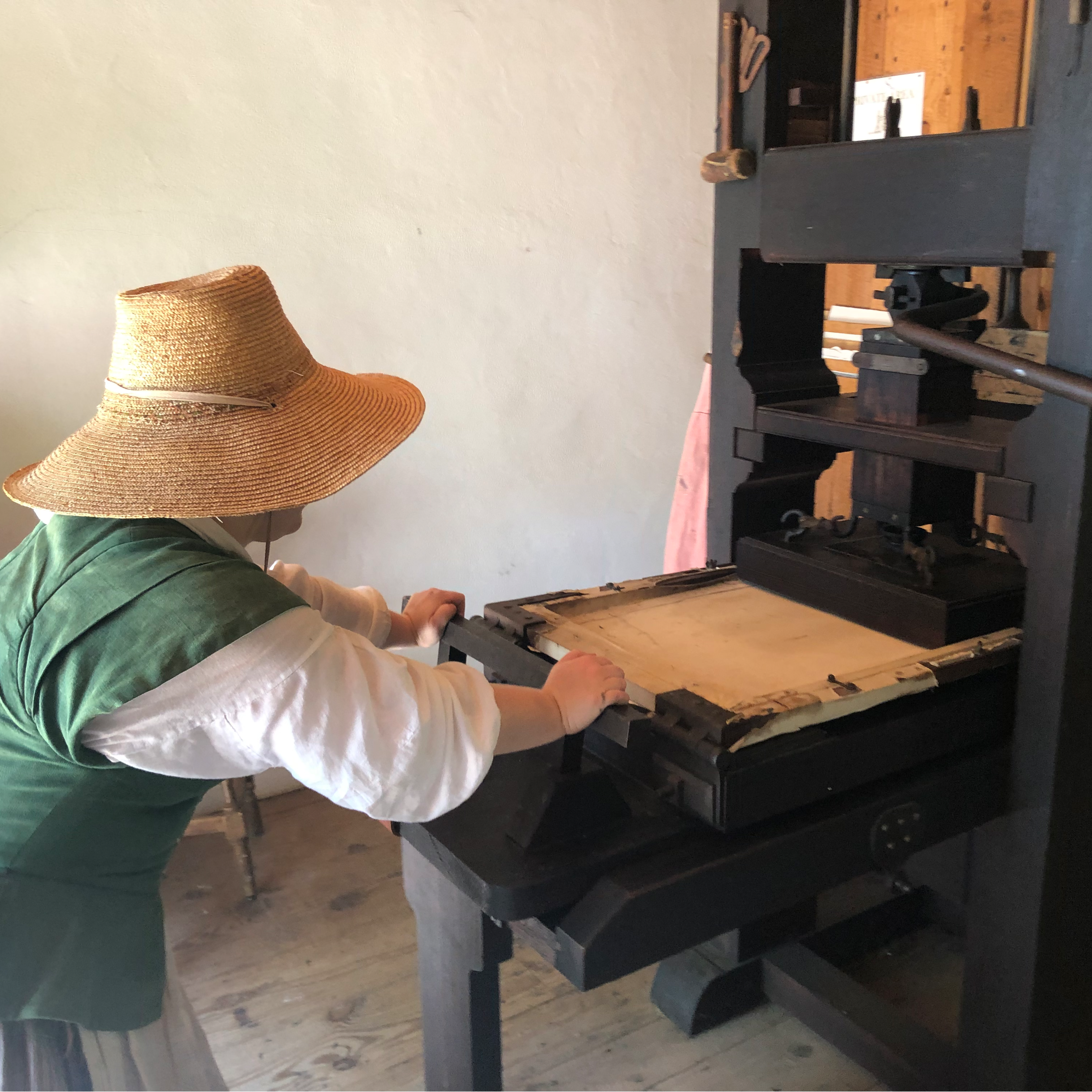THIS morning was so special!
The weather has gotten much cooler, so our monarchs have stayed in their chrysalises longer. We had learned from one of our monarch books that, "a monarch butterfly develops within its chrysalis over a span of five to fifteen days, depending on the temperature" (
An Extraordinary Life: The Story of Monarch Butterfly by Laurence Pringle, p.17). And it's very true.
Pringle's book has been our bedtime read aloud for days. It's amazing! It is by far the best chapter book for learning about monarchs; the best picture book, in my opinion, is
Monarch and Milkweed by Helen Frost.




Therefore, because it was so cold this morning, two butterflies didn't emerge first thing. They emerged while we were awake. And the second one, which came out at about 10:30 am, we WATCHED emerge from its chrysalis.
We also were able, several weeks ago, to watch two caterpillars go into their chrysalises. So I'll do a companion post to this one, with the videos. I took them on my iPhone, so they're not professionally done. But it's so amazing, and I wanted to be able to share it with all of my students, since they can't be here for in-person for this Nature Study. Our big Botany project for this school year is to plant and plant a Native Tallgrass Prairie Demonstration Garden, so hopefully we will have tons of milkweed and tons of monarchs each and every year.
Here are some of my favorite photos from the many hundreds that I have taken this August & September. Click on any photo to enlarge it and scroll.
Aug 18
our milkweed is in full bloom!
discovering monarch caterpillars on it for the first time
Aug 30
setting up the terrarium in the Art Room
and some butterfly books, of course
Sep 2
our first chrysalis!
Sep 3
making beeswax crayon drawings
this is Zac's "monarch caterpillar on milkweed"
the terrarium is packed full of caterpillars and food
it's hard to count them all (we think there's 17)
we quickly learn that each time we bring in more milkweed,
we bring in more caterpillars too
the terrarium was last used for a toad, so it was muddy
I was afraid to clean it with a harsh chemical, right before putting
in tender insects, so I just used vinegar and water
next time I will scrub it thoroughly well in advance,
so that we can see everything through clearer glass
Sep 4
9:30 the next morning...
all the stems are nearly bare of leaves
seriously,
they eat A LOT
our little Outdoor Classroom display
sipping sweetness through a straw,
just like a butterfly!
Sep 5
in the morning we find two caterpillars in J's
which they do right before they go into their chrysalis
I took a video of this guy, Left J, going into his chrysalis, and forgot
about still photos, but I took some still photos of the other one, Right J
here's Left J as a brand-new chrysalis
they are still a bit lumpy at first, and it looks a lot like
a kid in a sleeping bag as they move around for a while
there was a lot of frass on the paper towels today, but I waited
to change the bedding, since I didn't want to disturb the J's
it's pretty easy, actually, to just lift out the rack holder with all
the tubes, set it on the table, and put in fresh paper towels
I'm happy with our setup!
we also realized that chrysalises have to have hardened
for a day or two before they get their gold line and gold dots
it's a beautiful shade of green; photos don't do it justice
the other caterpillars casually walk all over them
in fact, one attached to a stem which then got nibbled,
and the chrysalis fell! Zac is the one who spotted it
we left it alone and waited to see if it was unhurt
I went around to the other side of the aquarium to get a better view
of Right J, which is why it looks like he turned around
when the antennae start to look like they're disintegrating
like that, it means they are about to shed that skin
under the skin is the green sac of the chrysalis
this green sac with the black wrinkly thing hanging from it is
Right J
he sheds his skin and the green sac is what is under it
so that the green sac doesn't fall off its twig when the
old skin is completely discarded, the caterpillar attaches in a special way
and the caterpillars just keep right on doing their thing
Sep 6
our terrarium is full of beautiful chrysalises
Sep 11
most caterpillars attach to the milkweed stems,
but these guys went right up to the rim at the underside of the tank
we also had three attach to the wooden lid itself
they look for a high and secure spot
we wake up in the morning to our first butterflies!
once they've strengthened their wings and warmed up
they will want to fly away
we had three in all this morning
the first butterfly flew away through the open garage door,
but we thought we could make it a bit easier for other two,
so I carried the rack outside
we have put some cats back onto our milkweed plant outside
I had to keep every stem that had a chrysalis on it, so the habitat
became full of tubes with dry stalks, and it became harder
and harder to have enough tubes where I could replace the milkweed
but the very last one was so fat and would go into a chrysalis
soon, so Zac wanted us to keep him in the terrarium
the last caterpillar
(which I had to keep watching so he didn't crawl away)
sketching
Zac's "monarch butterfly"
the fallen chrysalis is still undisturbed
they climb to the very tippety top of their step
and practice opening and closing their wings
before letting go and flying away
it takes several hours from when they emerge
this is a male
note the two large black dots on the veins
they are scent glands,
believed to be used to lure the female into mating
the first short flight, to the burning bush by the driveway
luckily, we have a bit of honeysuckle growing in that group
of bushes, so it worked out really well
back in the terrarium again, we watch our last lonely caterpillar
crawl around and nibble on leaves
so many chrysalises!
Sep 14
we wake up to a butterfly!
we ended up with three today as well
to the left... a still-green chrysalis
in the middle... a clear chrysalis with the butterfly showing
to the right... a newly emerged monarch
I love how you can see the butterfly through
the translucent chrysalis, right before it emerges
9:16 am
and when it comes out, the wings are crumpled and wet
9:38 am
you can see how much more the wings will expand
of course, we took them outside to release them
up into the dogwood tree
now that we could see how much the wings will unfurl,
we began to worry about the chrysalis inside the rack
if the butterfly was okay, and it came out, it would be
trapped in a plastic cage
so I carefully moved it to the paper towel
golly day, they are so beautiful
Sep 15
we wake up to three butterflies!
and the one that fell is okay!!!
we release them, of course
I actually had to put a stick by the butterfly that was
clinging to the rack, since the plastic tube was slippery, and
they have an instinct to climb up as high as possible before
flying for the first time
I put another stem of milkweed by him and he grabbed it with
his legs and pulled up onto it and he was off!
so...
nine safely emerged & three still in chrysalises up on the lid
Sep 21
we wake up this morning to a very dark chrysalis
8:58 am
10:21 am
walked into the art room and there was a butterfly!
and then I realize that he won't be able to fly away
unless we take the entire wooden lid outside
we figure out a way to balance it carefully
between a large cardboard box and Zac's easel
another chrysalis is looking very dark
it will surely emerge any minute
so I set Zac up with a chair and a snack
and we wait
we watch the first one out uncurl his tongue
he's opening and closing his mouth over and over
and then we saw the second one EMERGING
so excited!!!!!!
welcome to the world, little one!
see how it looks like there are two tongues?
the proboscis actually forms as two halves, so the butterfly has
to uncoil and recoil the two halves
Pringle says, "They had developed separately and had to be
uncoiled and pressed together to lock into a single workable tube."
(page 20)
so, now we have here two newly-emerged butterflies
and I realize that they don't have a very secure perch,
clinging to that chrysalis
I go back and look through our photos, and noting that when they
always came out before we woke up, we found them clinging
to stems of the milkweed, and not to their chrysalises
so I went and cut some milkweed and put it in a tube,
and set it where they could easily reach it with their legs
we have loved this butterfly experience
and we have learned a ton about monarchs!
I will organize and share the videos next
This post contains affiliate links to materials I truly use for homeschooling. Qualifying purchases provide me with revenue. Thank you for your support!

























































































 Immersive Experience
Immersive Experience Immersive Experience
Immersive Experience








No comments:
Post a Comment